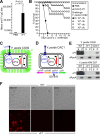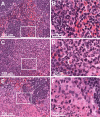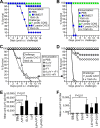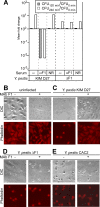Yersinia pestis IS1541 transposition provides for escape from plague immunity
- PMID: 19237527
- PMCID: PMC2681732
- DOI: 10.1128/IAI.01162-08
Yersinia pestis IS1541 transposition provides for escape from plague immunity
Abstract
Yersinia pestis is perhaps the most feared infectious agent due to its ability to cause epidemic outbreaks of plague disease in animals and humans with high mortality. Plague infections elicit strong humoral immune responses against the capsular antigen (fraction 1 [F1]) of Y. pestis, and F1-specific antibodies provide protective immunity. Here we asked whether Y. pestis generates mutations that enable bacterial escape from protective immunity and isolated a variant with an IS1541 insertion in caf1A encoding the F1 outer membrane usher. The caf1A::IS1541 insertion prevented assembly of F1 pili and provided escape from plague immunity via F1-specific antibodies without a reduction in virulence in mouse models of bubonic or pneumonic plague. F1-specific antibodies interfere with Y. pestis type III transport of effector proteins into host cells, an inhibitory effect that was overcome by the caf1A::IS1541 insertion. These findings suggest a model in which IS1541 insertion into caf1A provides for reversible changes in envelope structure, enabling Y. pestis to escape from adaptive immune responses and plague immunity.
Figures





References
-
- Anderson, G. W., Jr., P. L. Worsham, C. R. Bolt, G. P. Andrews, S. L. Welkos, A. M. Friedlander, and J. P. Burans. 1997. Protection of mice from fatal bubonic and pneumonic plague by passive immunization with monoclonal antibodies against the F1 protein of Yersinia pestis. Am. J. Trop. Med. Hyg. 56471-473. - PubMed
-
- Andrews, G. P., D. G. Heath, G. W. Anderson, Jr., S. L. Welkos, and A. M. Friedlander. 1996. Fraction 1 capsular antigen (F1) purification from Yersinia pestis CO92 and from an Escherichia coli recombinant strain and efficacy against lethal plague challenge. Infect. Immun. 642180-2187. - PMC - PubMed
-
- Baker, E. E., H. Sommer, L. W. Foster, E. Meyer, and K. F. Meyer. 1952. Studies on immunization against plague. I. The isolation and characterization of the soluble antigen of Pasteurella pestis. J. Immunol. 68131-145. - PubMed
-
- Blomfield, I. C., V. Vaughn, R. F. Rest, and B. I. Eisenstein. 1991. Allelic exchange in Escherichia coli using the Bacillus subtilis sacB gene and a temperature-sensitive pSC101 replicon. Mol. Microbiol. 51447-1457. - PubMed
Publication types
MeSH terms
Substances
Associated data
- Actions
Grants and funding
LinkOut - more resources
Full Text Sources
Medical

